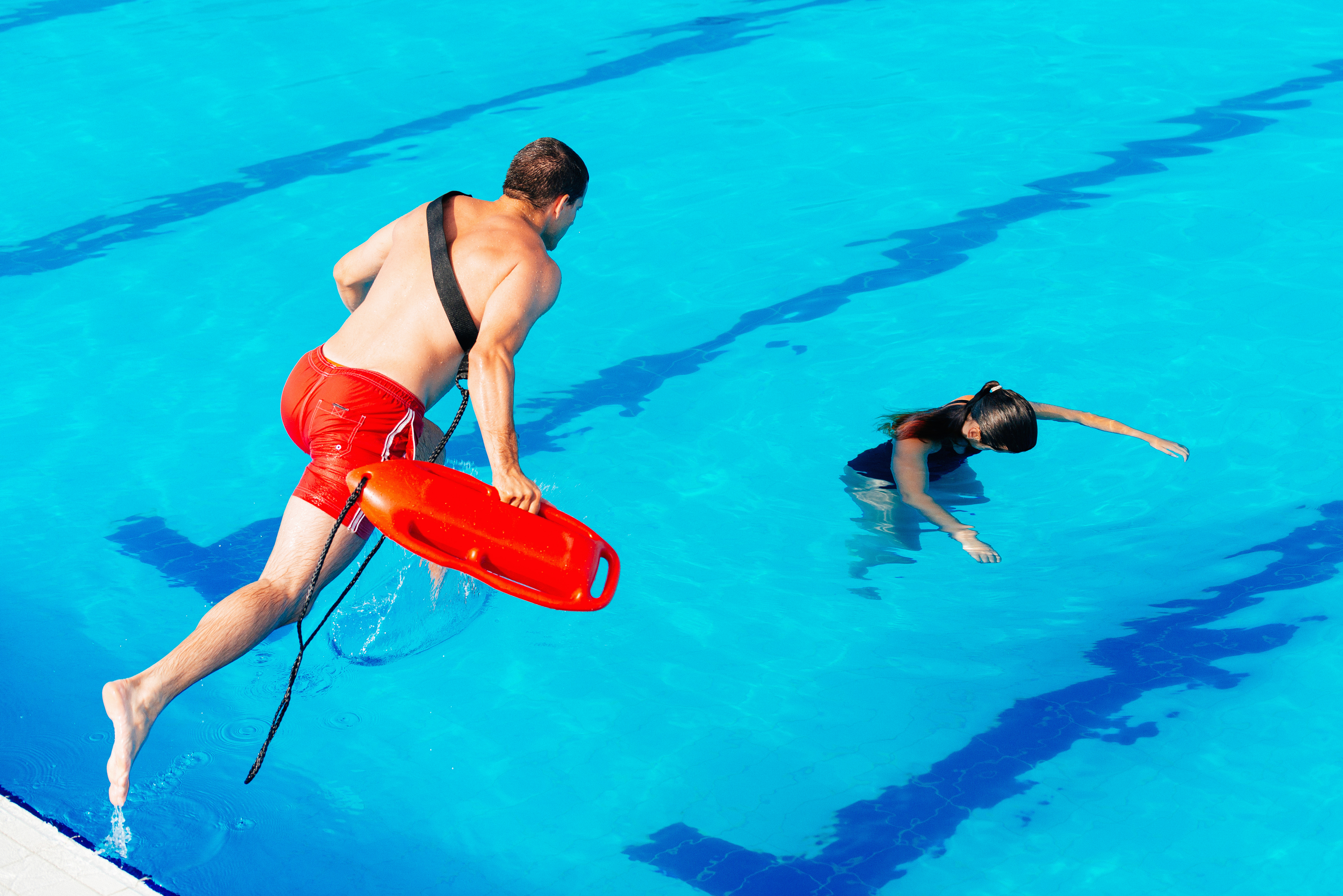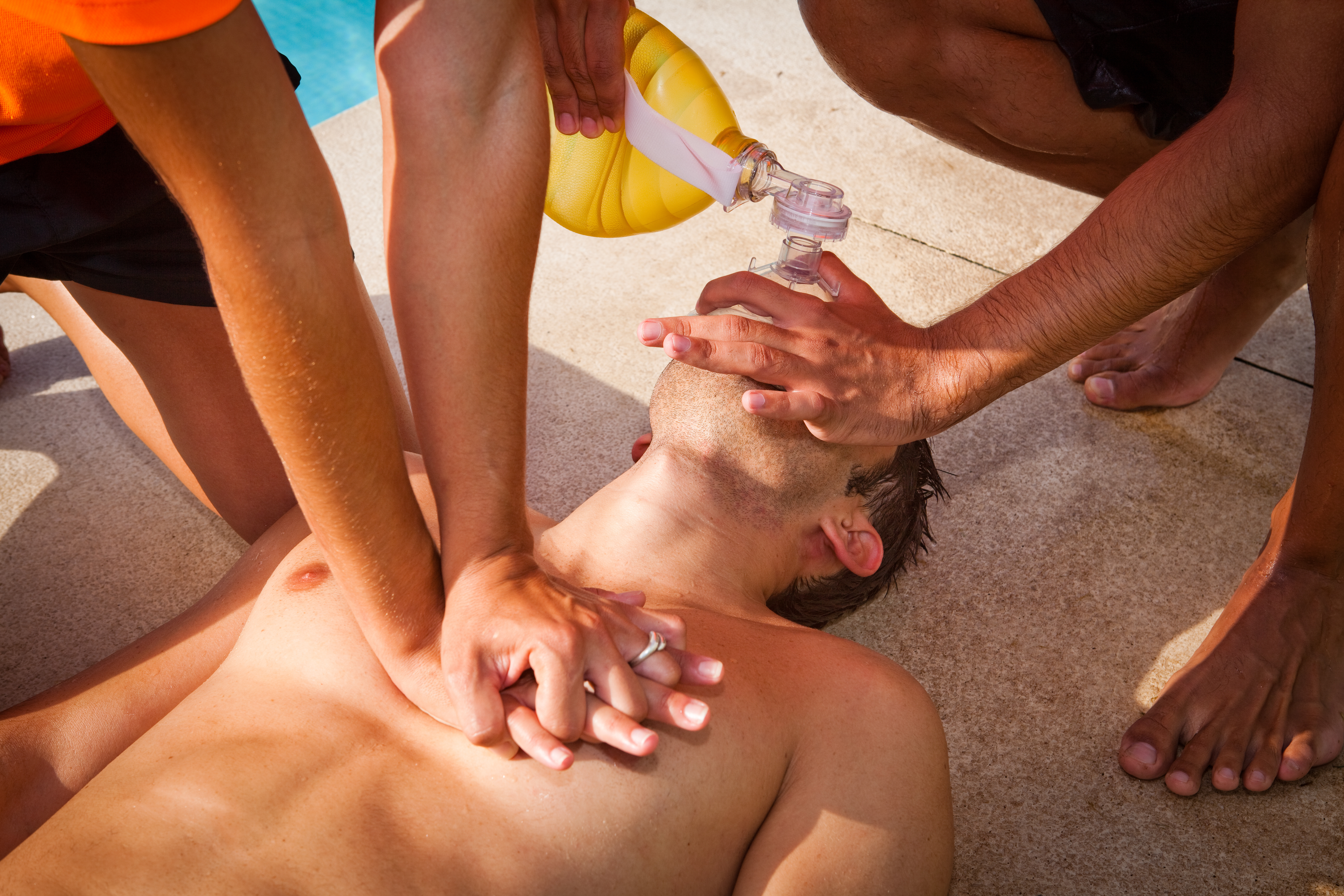- McCall JD, Sternard BT. Drowning. 2022 Aug 8. In: StatPearls [Internet]. Treasure Island (FL): StatPearls Publishing; 2023 Jan–. PMID: 28613583.
Schmidt A, Hawkins SC. Summary of Wilderness Medical Society Clinical Practice Guidelines for the Treatment and Prevention of Drowning. Wilderness Medicine Magazine Volume 37, Issue 3. 3 aug 2020. - Abelairas-Gómez C, Tipton MJ, González-Salvado V, Bierens JJLM. Drowning: epidemiology, prevention, pathophysiology, resuscitation, and hospital treatment. Emergencias. 2019 Ago;31(4):270-280. English, Spanish. PMID: 31347808.
- Szpilman D, Morgan PJ. Management for the Drowning Patient. Chest. 2021 Apr;159(4):1473-1483. doi: 10.1016/j.chest.2020.10.007. Epub 2020 Oct 14. PMID: 33065105.
- Panchal AR, Bartos JA, Cabañas JG, Donnino MW, Drennan IR, Hirsch KG, Kudenchuk PJ, Kurz MC, Lavonas EJ, Morley PT, O'Neil BJ, Peberdy MA, Rittenberger JC, Rodriguez AJ, Sawyer KN, Berg KM; Adult Basic and Advanced Life Support Writing Group. Part 3: Adult Basic and Advanced Life Support: 2020 American Heart Association Guidelines for Cardiopulmonary Resuscitation and Emergency Cardiovascular Care. Circulation. 2020 Oct 20;142(16_suppl_2):S366-S468. doi: 10.1161/CIR.0000000000000916. Epub 2020 Oct 21. PMID: 33081529.
- Only available in Italian: Richards D. Annegamento. Manuale MSD. Gennaio 2023.
Analysis: First aid in case of drowning
Drowning deaths are a serious public health problem worldwide. Drowning victims require rapid and skilled intervention.
Drowning defined
Drowning is defined as a process of impaired breathing due to immersion/submersion in a liquid medium. This definition also includes patients who survive this process. A conservative estimate is that for every fatal drowning death, five more people are admitted to the emergency room for non-fatal drowning. There are only three consequences of drowning: fatal drowning, non-fatal drowning with injuries, and non-fatal drowning without injuries.
Drowning usually happens quickly and for the most part silently. People who become agitated during drowning are rare. In most cases, the classic scenario is that a person floats motionless in the water (or other liquid) and quickly disappears below the surface.
Drowning can occur in both warm and cold water. In many cases, cold water can protect against neurological damage, especially in children. The most immediate threat in drowning is cardiac and central nervous system dysfunction. Hypoxaemia and acidosis must be treated immediately if the patient's death is to be avoided. Unfortunately, those who survive may develop neurological damage.
Etiology
The cause of drowning is accidental or intentional immersion in water or other liquid substances. Risk factors for drowning include:
- Head trauma
- Cramps
- Cardiac arrhythmias
- Hypoglycaemia
- Hypothermia
- Alcohol and/or drug use
- Suicide
- Panic attack
- Myocardial infarction
- Depression
- Poor judgement
- Scuba diving
- Natural disaster
In infants and toddlers, the cause is often an accident and can even occur in a bathtub. Most infant and toddler deaths occur within five minutes of an adult interrupting supervision. Older children are more likely to drown in swimming pools. Adults are more likely to drown in lakes, rivers and the sea.
Children in the water must always be supervised (Image: Romolo Tavani, Adobestock)
Epidemiology
Worldwide, drowning is responsible for approximately 360,000 deaths per year. There are three age-related peaks in deaths: Infants (under 5 years of age), adolescents and the elderly.
In the United States, drowning is a leading cause of accidental death in people under 45 and a leading cause in children under five in states with many swimming pools or beaches. About 7% of drowning cases among children appear to be due to abuse or neglect. Drowning is much more common in the summer months.
The overwhelming majority of young patients result in terrible personal, emotional and financial consequences. In addition, the actual burden for all age groups is probably underestimated, as most studies omit drowning deaths due to storms, floods and shipping.
Pathophysiology
When a person drowns, acidosis and hypoxia develop, which can lead to cardiac arrhythmias (with progression of tachycardia, bradycardia, pulseless electrical activity and asystole). Aspirated fluid can lead to washout and surfactant dysfunction, increased alveolar-capillary membrane permeability, decreased lung compliance and an altered ventilation/perfusion ratio.
This can lead to variable respiratory disturbances ranging from minimal or absent to pulmonary oedema, with a clinical picture similar to adult acute respiratory distress syndrome (ARDS). The highest morbidity and mortality is associated with cerebral hypoxia and management aims to minimise hypoxia as soon as possible.
Determining the type of water in which the patient has been immersed (e.g. salt water or fresh water) is of little importance. Changes in volume or serum (electrolytes) only occur when a significant volume of fluid is aspirated. It is more important to know if the fluid was obviously contaminated (sewage), as these patients are very susceptible to lung infections (antibiotic prophylaxis may be warranted here).
At least 20% of patients develop tight laryngospasm that persists after cardiac arrest. These individuals rarely aspirate fluids. The two most important consequences of drowning involve the CNS and the cardiac system. Within 2 minutes, most drowning victims lose consciousness and within 4-6 minutes they develop irreversible brain injuries.
Medical history and patient profile
The history should include, if possible, the circumstances of the drowning. In certain situations, the authorities may investigate the dynamics of the event and determine whether the person drowned accidentally or whether it was a homicide/suicide, for example. Intentional infant deaths are not uncommon and risk factors include:
- Maternal depression.
- Unmarried mother.
- Young mother.
- Financial crisis.
- Inability to cope with a newborn child.
The clinical presentation of people suffering from underwater injuries varies greatly. A drowning patient can initially be classified into one of the following four groups:
- Asymptomatic.
- Symptomatic.
- Cardiopulmonary arrest.
- Definitely deceased.
Some authors identify eight types of clinical variances of drowning, which take into account the following: Consciousness, Breathing, Immersion/Ascent Times. The first type refers to the asymptomatic patient with normal vital signs, and the last type addresses patients with cardiopulmonary arrest and an immersion time of more than one hour in water with a temperature above 10 °C. Patients are likely to be asymptomatic if they have been submerged only briefly and resuscitated immediately.
Symptomatic patients may present with the following features:
- Altered state of consciousness, neurological deficit.
- Tachypnoea, dyspnoea or hypoxia: if dyspnoea occurs, even if mild, the patient is considered symptomatic, cough.
- Cardiac changes (e.g. tachycardia or bradycardia).
- Anxious demeanour.
- Metabolic acidosis (may also occur in asymptomatic patients).
- Hypothermia.
- Vomiting, diarrhoea, or both.
Patients with cardiopulmonary arrest present with the following symptoms:
- Unconsciousness.
- Respiratory arrest.
- Asystole (55%), ventricular tachycardia/fibrillation (29%), bradycardia (16%).
In cases of apparent death by drowning, the following conditions are present:
- Normothermia with asystole.
- Presence of cadaveric phenomena (rigor mortis, hypostasis).
Most people are found in or near water, so the diagnosis is clinically clear. If resuscitation is indicated, it must be performed before the diagnostic examination is completed.
What to do in case of drowning?
Only rescue in the water if you are trained to do so
People who have not undergone special training in water rescue should only attempt a rescue from a safe place (e.g. by reaching the patient in a boat or throwing a lifebuoy from a jetty). Otherwise, they should only call the single emergency number 112 without leaving the scene.
Entering the water to perform a rescue should therefore only be done by people who are specially trained to work in this dangerous environment.
Water rescue (Image: Microgen, Adobestock)
In-water resuscitation
In-water resuscitation (IWR) is defined as "the attempt to resuscitate a drowning victim who is still in the water". In-water resuscitation should only be considered by a rescuer who has the appropriate training, skills and equipment to perform this activity safely and effectively.
Water conditions must be safe enough for the rescuer to perform the resuscitation and the point of exit from the water must be far enough away to justify this technically difficult manoeuvre. If conditions are too dangerous to safely perform an IWR, a rapid exit without delay is indicated. Chest compressions should never be performed in the water.
The use of semi-rigid boats would help to reduce intervention time and provide the option of ventilation and chest compressions on board.
Resuscitation manoeuvres while waiting for qualified rescuers
After the drowned person has been brought to shore or into a boat, the state of consciousness, breathing and circulation must be assessed. If the patient is in cardiac arrest, cardiopulmonary resuscitation should be initiated as soon as possible. Avoid attempts to remove the water from the lungs. This will only delay ventilation and increase the risk of vomiting.
Precautions for spinal trauma
Trauma to the cervical spine may be present in any person who drowns after immersion in shallow water or near rocks. If the patient is unable to clearly describe what happened, shows signs of head or facial injury, or is unresponsive in a pool or other shallow water, protect the cervical spine until injury is ruled out. Treatment of spinal trauma should be in accordance with the latest version of the spinal cord protection guidelines.
Hospitalisation
All patients who suffer a non-fatal drowning accident must be taken immediately to an emergency department as soon as they are stabilised, as instructed by the incident room.
Most symptomatic drowning patients need to be hospitalised due to the severity of the condition, the possibility of clinical deterioration, the need for respiratory support or the treatment of certain organ complications. A patient with respiratory arrest, cardiac arrhythmias, hypoxaemia or abnormal chest radiographs must be admitted.
Most unconscious patients need to be admitted to the ICU unless they have been unconscious for a short period of time and were presented awake, without signs of hypoxia and altered vital signs in the emergency department.
Outpatient treatment of the drowned person with cardiopulmonary arrest
Oxygen supply and ventilation
The increased morbidity and mortality associated with non-fatal drowning is due to tissue hypoxia, particularly cerebral hypoxia. Therefore, the first priority in resuscitation is to resolve hypoxia quickly. Current recommendations are that ventilation should be started as soon as possible. One recommendation is to start resuscitation with five breaths and to perform the breaths before chest compressions.
The face mask and self-expanding cylinder provide good protection for rescuers and improve hypoxia by connecting to oxygen. Supraglottic devices (Supraglottic Airways or SGAs) may not be fully suitable for drowning victims due to reduced lung compliance and increased airway resistance.
As for oxygen therapy, it is recommended to administer it as soon as possible (FiO2 100%). According to some authors, oxygen should be titrated to maintain oxygen saturation between 92% and 96% and avoid oversaturation.
Cardiopulmonary resuscitation with two rescuers (Photo credit: daviles, Adobestock)
Quality of chest compressions
Although oxygenation and ventilation are the priority for a drowning victim, the overall quality of CPR must be optimal.
Studies with rescuers have shown that the quality of chest compressions drops significantly after a water rescue, falling below 70% after the first minute of CPR. CPR should be initiated by a rescuer other than the one performing the water rescue, or the rescuer must switch after the first minute.
In simulated conditions after a water rescue, the use of automatic compression mechanisms proved useful in improving the quality of chest compressions, although their effects on survival were not confirmed.
AED in drowning
Regarding the defibrillator, numerous studies have reported that the majority of drowning patients experience non-defibrillatory cardiac rhythms, while ventricular fibrillation and pulseless ventricular tachycardia account for less than 10%.
It is therefore recommended that cardiopulmonary resuscitation be given priority when only one rescuer is present. If more than one rescuer is present, one rescuer should begin resuscitation while another rescuer dries the patient's chest and deploys the defibrillator.
AEDs can be used in wet environments and on boats, including moving boats and those with metal surfaces such as canoes.
Heimlich manoeuvre
The Heimlich manoeuvre is not recommended for resuscitation of drowning patients.
Treatment of out-of-hospital hypothermia
Hypothermia is very likely due to the effect of immersion. Hypothermic patients must be thoroughly examined for signs of circulation.
Passive and active heating methods should be used to warm the patient's core temperature. Knowing the patient's temperature outside the hospital requires the use of thermometers that can record low temperatures. Tympanic measurements should be avoided because of the presence of water in the sound cavities. In cases of severe hypothermia, the use of automatic compression mechanisms is recommended.
Interrupting CPR
CPR should not be interrupted unless there is clear evidence that it would be unnecessary. Taking into account what has been said about hypothermia, in the case of drowning it is always good to remember that "no one is dead until warm and dead".
The second part of this report is about hospital treatment in drowning cases.


